10 KPIs that Higher Education Marketers Should Be Tracking
Having clear goals in place for your enrollment marketing strategy will help to guide your efforts and boost enrollment. But, to successfully hit your enrollment targets and meet your goals, you need to identify and monitor the appropriate higher education marketing KPIs.
In this article, we take a look at:
- What KPIs are and why they’re important for your enrollment funnel
- The best higher education marketing KPIs and how to track them
Note: This article was originally published on the Pepperland Marketing Blog, and has been republished here with permission.
The job of a higher education marketer continues to become more difficult as tuition costs and competition grow.
With a strong inbound marketing strategy in place, you’ll easily move students down the funnel and hit your enrollment marketing goals despite these challenges.
But, how will you know when you’ve met your goals and when you’ve been successful?
That’s where KPIs come into the mix. To set measurable and actionable goals, you need to first choose the performance metrics (KPIs) that you’re going to focus on.
In this article, we’ll take a look at some of the best higher education marketing KPIs to measure, but first, let’s take a closer look at how KPIs relate to your enrollment marketing goals.
What are KPIs and why are they important for your enrollment funnel?
Key Performance Indicators
Key Performance Indicators (KPIs) are quantifiable measurements that allow you to monitor your current performance in comparison to your goals. They represent the specific metrics that you’re trying to improve with your enrollment marketing efforts.
With KPIs in place, you’re able to set specific, actionable goals for your department and easily measure your performance against these goals.
To jog your memory, your enrollment marketing goals should be SMART goals, meaning they should be Specific, Measurable, Attainable, Relevant, and Time-bound. As you set your SMART enrollment marketing goals, you’ll find that the process is virtually impossible without KPIs.
KPIs help to make your SMART goals both specific and measurable by providing you with quantifiable metrics. Without KPIs, it would be unclear as to what you’re trying to achieve and it will be impossible to measure your progress.
Using KPIs to Optimize Your Enrollment Funnel
The enrollment funnel represents the different stages in a prospect’s journey through the college decision-making process.
Typically, the enrollment funnel is broken down into six stages: Prospects, Inquiries, Applicants, Admits, Deposits, and Enrolls. Some universities use different terms for these stages, but the stages themselves are typically the same.
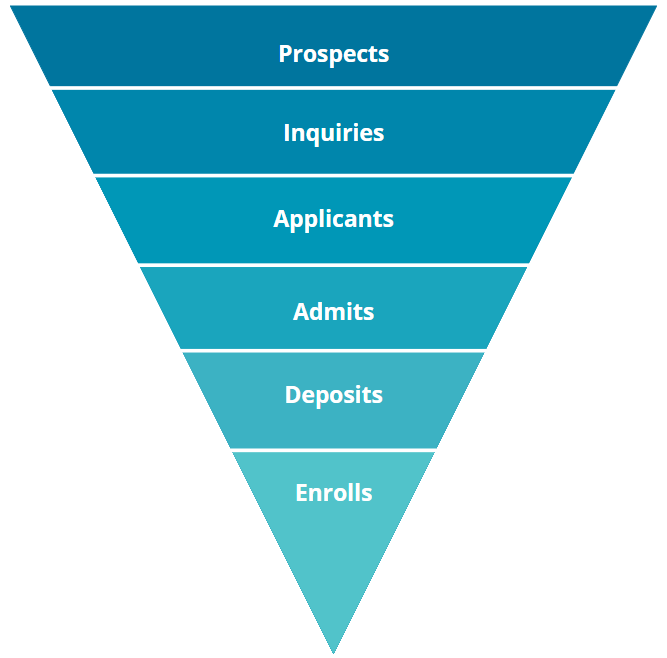
- Prospects: People who have anonymously interacted with content on your website but have not provided any contact information
- Inquiries: Prospective students who have provided contact information by taking an action (downloading a content offer, contacting admissions, etc.)
- Applicants: Prospective students who have submitted an application
- Admits: Prospective students who have met the admissions criteria and have been admitted
- Deposits: Students who have sent a deposit to secure their seat
- Enrolls: Students who have successfully matriculated
As an enrollment marketer, the purpose of your marketing efforts is to inform and persuade your prospects to move down the funnel and ultimately enroll in a program at your institution.
By using KPIs in your SMART enrollment marketing goals, you’ll increase the efficiency at which you move prospects down your enrollment funnel.
The specific marketing goals that you set will vary depending on the stage in the funnel that you’re targeting, but many of the KPIs that you’ll use to track your progress will remain the same.
Now, let’s take a look at 10 higher education marketing KPIs that you’ll want to consider when setting goals for your enrollment funnel.
10 Higher Ed Marketing KPIs That You Should Be Tracking
KPIs are essential for goal setting in all contexts, but the metrics that you choose to track depend on the nature of your marketing efforts. Here are 10 KPIs that are important indications of success for higher education marketers.
1. Website Sessions
Website Sessions refers to the total number of visits to your institution’s website, including new and repeat visitors.
As a marketer tasked with helping your college or university hit enrollment targets, you’ll want to be sure that your institution has a strong presence on the Internet.
If your school’s website is consistently receiving heavy traffic, you can rest assured that your content is being viewed by prospective students. It’s wise to set yearly goals for this metric as your enrollment targets increase.
You can find your Website Sessions within your institution’s Google Analytics account.
2. Average Position
To further analyze your institution’s website visibility, you’ll want to take a look at the Average Position in search results.
This KPI refers to the average ranking of your website’s URLs for specific search queries. You can track this metric for your domain and on the individual page level. For a holistic view of your site’s visibility, keep track of your domain’s Average Position, as well as other pages of importance—like program pages—on your website.
Ideally, you’ll want to be on the first page of search results for the queries that are the most valuable to your school. If your website is hidden pages deep within the search results, you know that your website content needs to be optimized with SEO in mind to increase visibility.
3. Conversion Rates
Your Conversion Rates measure the percentage of visitors who have taken the desired action in comparison to the total number of visitors that your institution’s website has received.
In the context of enrollment marketing, the desired action that you want your visitors to take can vary greatly depending on the stage in the enrollment funnel that you’re focused on. These actions might include downloading a content offer, registering for an event, submitting an application, etc.
Regardless of the action that you want your visitors to take, it’s important that you track your Conversion Rates so you can determine whether your marketing efforts are successful and identify any gaps in the enrollment funnel.
How to Calculate Conversion Rate:
To calculate your Conversion Rate, divide the number of times the desired action was taken by the total number of visitors, and multiply that number by 100.
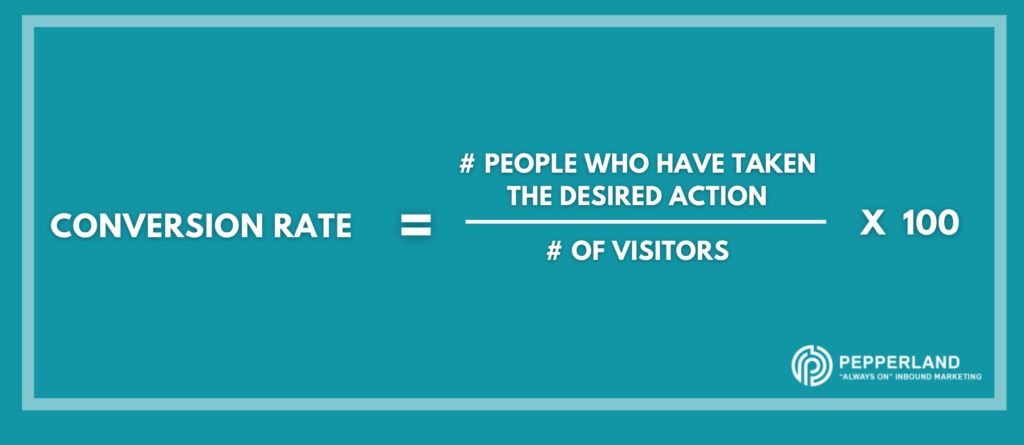
4. Conversions
In addition to your Conversion Rates, you’ll want to set goals for and track your individual Conversions.
This KPI measures the total number of desired actions that visitors and prospects have completed. Again, these actions vary based on the type of marketing tactics being used, as well as the stage in the funnel that you’re focused on.
Some Conversions that we recommend tracking are Content Offer/E-book Downloads, Form Submissions, Event Registrations, and Email Submissions.
By setting goals to boost your specific Conversions, you’re increasing the likelihood that these Conversions will be where you need them to be in order to hit your enrollment targets.
If you find that prospects are not taking the desired actions, you can zero in on the specific landing pages and offers that need to be revisited and optimized for conversion.
To view and track your conversion analytics, we recommend using marketing software like HubSpot.
5. Admissions Inquiries
Although this KPI classifies as a Conversion metric, it’s so valuable for enrollment marketers that it deserves its own spot on our list.
To gauge the success of your enrollment marketing efforts, you need to know how many prospects are converting to inquiries.
Your Admissions Inquiries can occur via email, phone, or live chat, so it can also be beneficial to track how many inquiries come from each channel.
6. Applicants
This might seem obvious, but it’s crucial that you know where you stand in comparison to your applicant targets.
The number of applications the admissions team receives is a leading indicator of success as it has a direct impact on your likelihood of hitting your enrollment targets. If you don’t have enough applicants, it’s impossible to hit your targets, whereas a high number of applicants will indicate that you’re likely to meet your targets.
This KPI also indicates the effectiveness of your enrollment marketing strategy in its entirety. If you’re falling short of your applicant goals, try to identify the specific marketing activities that aren’t working. Perhaps your ads are reaching the wrong audience or your email marketing campaigns need some work.
7. Click-through Rate (CTR)
Your Click-through Rate (CTR) is a measure of how many users have clicked on your content, whether this is a link within an email, a PPC ad, or a content offer on a landing page.
As a higher education marketer, it’s likely that you’ll have multiple Click-through Rates for different channels that you’ll want to track.
Regardless of what the user is clicking on, the significance is the same. If prospective students are clicking on your links, it means that they are actively engaged and interested in what your institution has to offer.
A high CTR can be indicative of successful email and PPC campaigns as well as well-designed calls to action (CTA)s and landing pages. If your CTR is low, try optimizing the design of your content and CTAs and experimenting with more actionable verbiage.
How to Calculate Click-through Rate:
To calculate CTR, divide the number of clicks by the number of impressions (# of emails sent, times viewed, # of visitors, etc.), then multiply this number by 100.
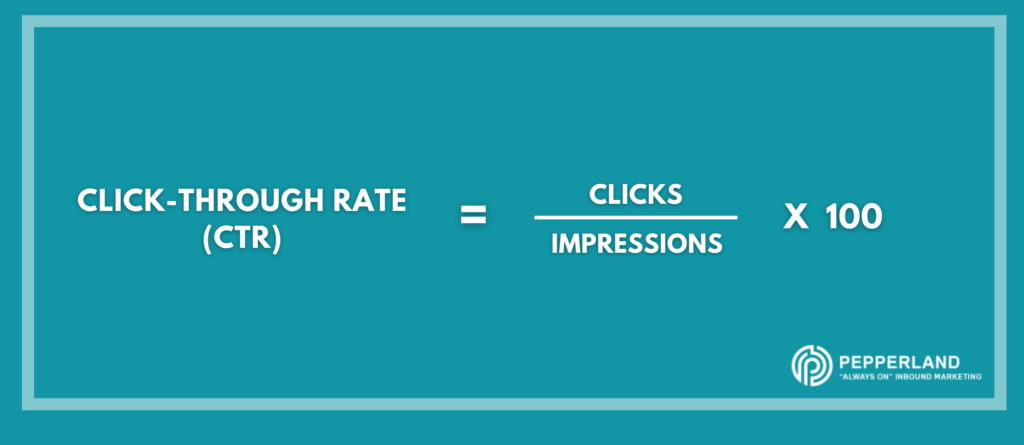
9. Enrollment
This KPI seems obvious, but it’s often overlooked. Marketers can get so preoccupied with the smaller pieces of the puzzle (like sessions and clicks) that they’re unable to see the bigger picture.
When setting more specific marketing goals, you might find it helpful to include enrollment numbers as a secondary KPI.
For example, a SMART goal for your department might sound something like: “We will increase our website’s Average Position in organic search results from 3rd to 1st this year in order to increase our enrollment by 10 percent.”
This KPI explicitly tells you whether your marketing efforts did what they were supposed to. If your enrollment numbers fall short, a complete overhaul of your marketing strategy might be necessary.
10. Marketing ROI
Last but not least, your Marketing ROI tells you if your efforts were worth it.
Your Return on Investment, or ROI, is a measure of the revenue from tuition that you’ve generated via marketing in comparison to how much you’ve spent.
A high ROI guarantees that your marketing efforts are justified and that your team is working efficiently and effectively.
How to calculate ROI:
To calculate your ROI, first, subtract your costs from the revenue you generated via marketing. Then, divide this by your costs and multiply by 100.
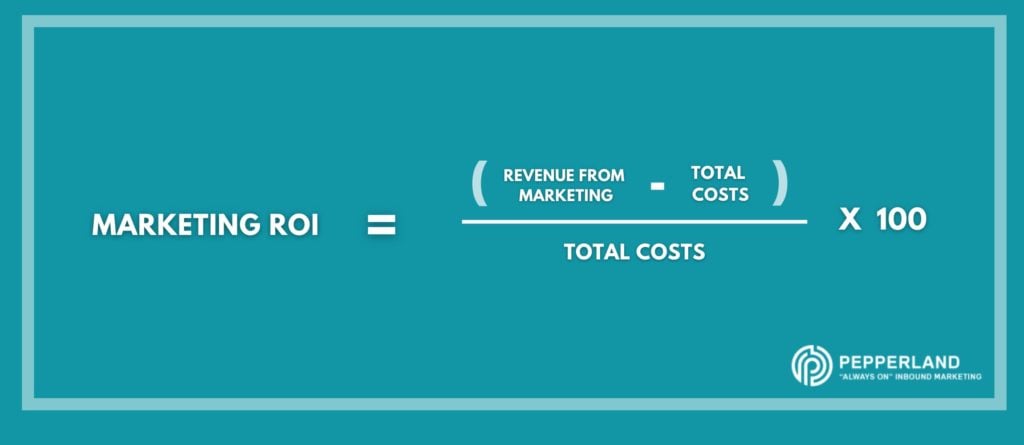
Boosting Enrollment With KPIs
These are just a few of the many higher education marketing KPIs that exist. Choose the metrics that make the most sense for your institution and use them to develop SMART goals for your strategy.
To measure your progress toward your goals and monitor any changes in your KPIs, we recommend that you use marketing software like HubSpot and integrate it with a tool like Databox in order to automatically track your performance with a customizable dashboard.
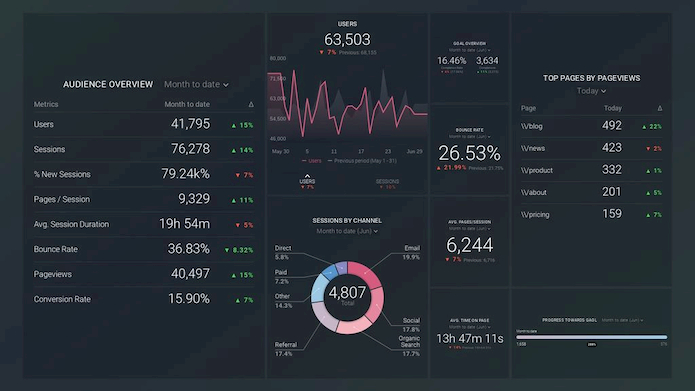
By identifying the appropriate KPIs for your email marketing goals and consistently monitoring your progress, your efforts are more likely to be successful and profitable for your organization.



